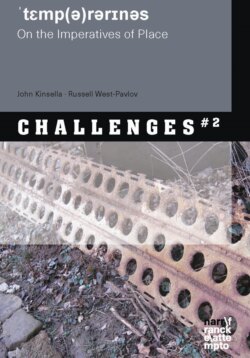Читать книгу Temporariness - John Kinsella - Страница 8
На сайте Литреса книга снята с продажи.
Where is here?
ОглавлениеWhere is here, where is there? Where is home, where is away? John has just written a poem about signing the petition against the accident-ridden French nuclear power plant at Fessenheim—just across the border, on the other side of the Rhine, only 100 km from here. Where is here, where is there, when the reactor flushes its contaminated cooling water back into the Rhine and its tributary the Neckar, and the winds can carry any particles that the plant may emit across the black forest to our adopted Swabian home further east? So much anxiety about belonging, about refugees, about keeping foreigners out—the basis of the shocking right-wing surge in the 2016 state elections—and so little anxiety about a more potent ‘foreign’ threat, one that comes from over the French border. It’s that threat that ought to be causing us a deeper anxiety. Although even that ‘foreign threat’ is no less dangerous, so Tracy tells me, than the domestic radioactive leaks from our ‘own’ Neckarwestheim and Neckarsulm plants further up our own oh-so-idyllic Neckar.
While we are on the subject of belonging and ‘here’: Neckarwestheim is twenty kilometres up the Neckar from Marbach-am-Neckar, where the German National Literary Archives are housed. The great treasures of German literature—manuscripts, letters, rare first editions, all the textual paraphernalia accrued since the elevation of Luther and Goethe and Schiller to icons of national tradition—are irrigated by the radioactive waste that threatens to put an end to all traditions, not merely those textual ones that are enshrined upon the Schillerhöhe looking over a bend in the Romantic Neckar. Fluid half-life against the river-like flow of a literary legacy (albeit one tarnished by the book-burnings), that I could experience live, tangibly, when I visited with Amadou from Dakar, to investigate Sebald’s scribblings from the Fens.
It’s time to recalibrate our notions of where we belong: perhaps, as Vivieros de Castro (2014) would have it, our home is a shared human continuum of humans and nonhumans, all experiencing themselves as intending persons, and thus as sites of intention and ethical action, but seeing various natural worlds around themselves. We and jaguars all have a taste for beer, but what we take for beer (IPA, Hefeweizen, or blood) is a matter of species-specific taste, a question of what is prey for each predator. Today, that common ‘humanity’ of human persons and non-human persons is underscored all the more so by a grotesque inversion. If we are predators one and all, beer-drinkers alike (in best German tradition), we are all, none the less, also ‘prey’: we are prey to that predator technology unleashed upon the world by human persons unaware of their place in a continuum of personhood and determined to dehumanize their own putatively singular humanity.
Here and there is neither here nor there—what counts, it would seem, is our common personhood across a spectrum of species and across a spectrum of places—whose differences, so important to childish nationalisms, are of no regard whatsoever to the monster radioactive ‘person’ preying upon us all.
RWP
